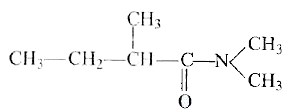Propanamide here [B ] is :
N-ethyl acetamide
Propane
Ethane
Acetone
The correct Answer is:C
To solve the given question step by step, we will go through the reactions involving propanamide and identify the products formed at each stage.
Step 1: Identify the structure of Propanamide
Propanamide has the structure:
CH3CH2C(=O)NH2
This can be simplified as:
- Ethyl group (C2H5) attached to a carbonyl (C=O) and an amine (NH2).
Step 2: Reaction with Br2 and KOH
When propanamide is treated with bromine (Br2) in the presence of potassium hydroxide (KOH), it undergoes the Hofmann bromamide degradation reaction.
1. Deprotonation: The KOH deprotonates the amine group, forming a negatively charged nitrogen:
CH3CH2C(=O)NH2KOH−−−→CH3CH2C(=O)NH−
2. Bromination: The negatively charged nitrogen attacks one of the bromine atoms, leading to the formation of a bromamide:
CH3CH2C(=O)NHBr
3. Deprotonation: The hydroxide ion (OH-) again deprotonates the nitrogen, leading to:
CH3CH2C(=O)N−Br
4. Migration: The ethyl group migrates to the nitrogen, resulting in the formation of ethyl cyanate:
CH3CH2N≡C(C=O)
Step 3: Hydrolysis of Ethyl Cyanate
When ethyl cyanate is treated with water, it hydrolyzes to form ethanol:
CH3CH2OH
This is product A.
Step 4: Reaction with HNO2
When ethanol (A) is treated with nitrous acid (HNO2), it forms an intermediate diazonium salt:
CH3CH2N+2
This intermediate decomposes, releasing nitrogen gas (N2) and forming ethanol:
CH3CH2OH
Step 5: Reduction with Red Phosphorus and HI
When ethanol is treated with red phosphorus (P) and hydroiodic acid (HI), it undergoes reduction to form ethane:
CH3CH2OHRed P, HI−−−−−−→C2H6
Conclusion
Thus, the final product B is ethane (C2H6).
Final Answer
B is Ethane (C2H6).
---
Propanamide has the structure:
CH3CH2C(=O)NH2
This can be simplified as:
- Ethyl group (C2H5) attached to a carbonyl (C=O) and an amine (NH2).
When propanamide is treated with bromine (Br2) in the presence of potassium hydroxide (KOH), it undergoes the Hofmann bromamide degradation reaction.
CH3CH2C(=O)NH2KOH−−−→CH3CH2C(=O)NH−
2. Bromination: The negatively charged nitrogen attacks one of the bromine atoms, leading to the formation of a bromamide:
CH3CH2C(=O)NHBr
CH3CH2C(=O)N−Br
CH3CH2N≡C(C=O)
When ethyl cyanate is treated with water, it hydrolyzes to form ethanol:
CH3CH2OH
This is product A.
When ethanol (A) is treated with nitrous acid (HNO2), it forms an intermediate diazonium salt:
CH3CH2N+2
This intermediate decomposes, releasing nitrogen gas (N2) and forming ethanol:
CH3CH2OH
When ethanol is treated with red phosphorus (P) and hydroiodic acid (HI), it undergoes reduction to form ethane:
CH3CH2OHRed P, HI−−−−−−→C2H6
Thus, the final product B is ethane (C2H6).
B is Ethane (C2H6).
Topper's Solved these Questions
- AMINESBOOK - VMC MODULES ENGLISHCHAPTER - AMINESEXERCISE - ENABLE
45 Videos
- AMINESBOOK - VMC MODULES ENGLISHCHAPTER - AMINESEXERCISE - EFFICIENT
49 Videos
- ALDEHYDES,KETONES & CARBOXYLIC ACIDS BOOK - VMC MODULES ENGLISHCHAPTER - ALDEHYDES,KETONES & CARBOXYLIC ACIDS EXERCISE - IN-CHAPTER EXERCISE-M
10 Videos
- ATOMIC STRUCTUREBOOK - VMC MODULES ENGLISHCHAPTER - ATOMIC STRUCTUREEXERCISE - JEE Advanced (Archive )
67 Videos
Similar Questions
Knowledge Check
RMgX(i)CH3CN−−−−−−→(ii)NH4Cl(A)RMgX−−−→NH4Cl(B), (B) will be :
A1∘ROHB2∘ROHC3∘ROHDAlkeneH3C−CH2−CH3∣CH−C∣∣O−NH2Br2+KOH−−−−−−−−−→ΔA1.CH3I(excess)−−−−−−−−−−−−→2.AgOH,ΔB
The major product (B) is :ACH3−CH2−CH=CH2B CH3C−CH=CH−CH3D
CH3C−CH=CH−CH3D
 Br2−−→CCl4(i)alc. KOH−−−−−−−→(ii)NaNH2(A)major, Product (A) is :AH2C=CH−CH=CH2BCH3−C≡C−CH3CCH3−CH2−C≡CHDCH3−CH=C=CH2
Br2−−→CCl4(i)alc. KOH−−−−−−−→(ii)NaNH2(A)major, Product (A) is :AH2C=CH−CH=CH2BCH3−C≡C−CH3CCH3−CH2−C≡CHDCH3−CH=C=CH2
The product of the given reaction ,
CH3−∣CH3∣C∣OH−CH3∣C∣NH2−CH3HNO2−−−→ Product is :
View SolutionPh−NH2HNO2−−−→0∘CAHF−−→BF3BΔ−−→C, C is:
View SolutionIn the following reaction order , B is
CH3CH2COOHP/Br2−−−→AalcKOH−−−−→H+B
View SolutionCH3CH2COOHCl2−−→RedP(A)Alc.KOH−−−−−→(B)
What is (B)?
View SolutionThe compound B is :
CH3CH2COOHCl3−−−−−→ red PAAlc.KOH−−−−−→B
View Solution
